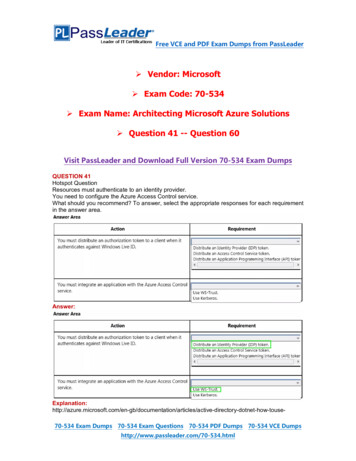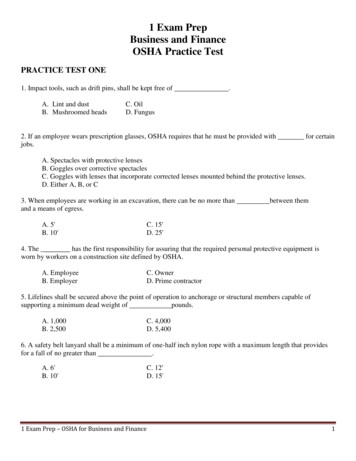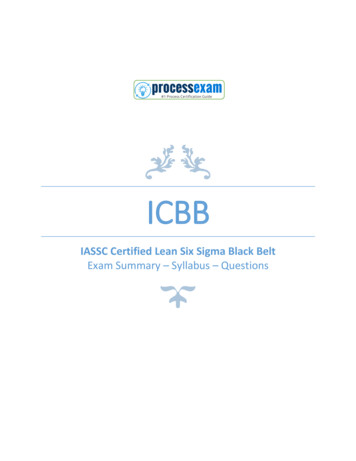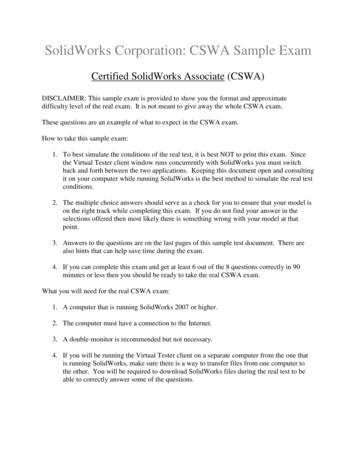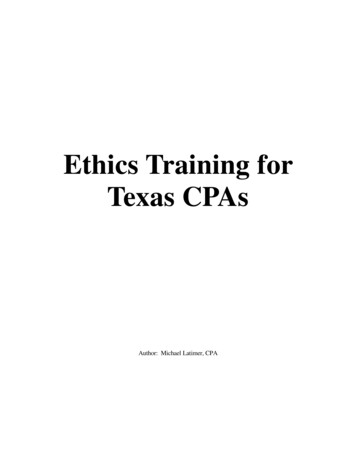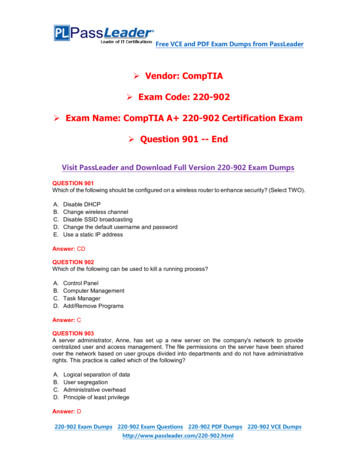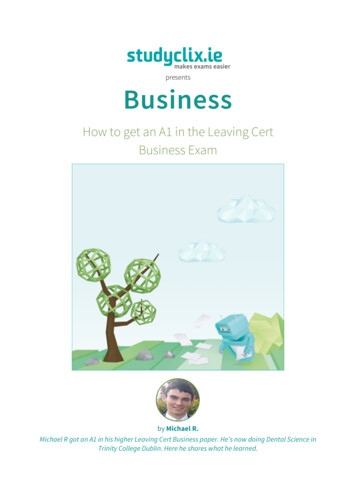
Transcription
presentsBusinessHow to get an A1 in the Leaving CertBusiness Examby Michael R.Michael R got an A1 in his higher Leaving Cert Business paper. He’s now doing Dental Science inTrinity College Dublin. Here he shares what he learned.
Business is a modern, real world subject. It the most popular business subject and is widelyregarded as the easier of the three, but with only 3.8% of candidates attaining an A1 gradein the 2016 exam, it’s clear there are numerous pitfalls. The exam is three hours long and isbroken into three sections; short questions, the applied business question and the longquestions. Just like the real world business environment, the Leaving Cert Business examis always changing. Candidates are now more frequently expected to apply what they havelearned to a particular scenario, rather than simply regurgitate the facts learned directlyfrom the text book. Hopefully this guide will be of some help to you for the exam comeJune!ContentsWhat should my study technique be? . 3How do I do Section 1 - Short Questions? . 5How do I do Section 2 - Applied Business Question (ABQ)? . 6How do I do Section 3 – Long Questions? . 8Some Final Tips . 102
What should my study technique be?Business is one of the bigger courses in the Leaving Certificate and the textbook is quite large. Thetheory isn’t overly complicated however, so with an effective and efficient study technique, you arewell on your way to a good grade! It is your job as a student to condense the information from thetextbook into sizeable chunks. Here are a few simple methods that I used when studying Business thatI found particularly useful: Notes: When studying Business, it is important that you write out your own notes from thetextbook. This is called active learning and is far more efficient than just reading the bookalone. Studies show that you remember 10% of what you read but 60% of what you write.writeWhat I did was, when I had written out the notes, I closed the text book and tried to write outthe notes again afresh. This will show you what you know and don’t know. Colour:Colour: Highlight key words and write sections with different colour pens. The brain is moresensitive to different colours and this makes you more likely to remember the most importantinformation. Exam Papers:Papers: Try and answer questions from exam papers or Studyclix as often as possible. Thisshould only be done after a chapter has been studied as it will give you a taste of a real examsituation. Make sure to check the marking scheme afterwards, it will show you where marks areawarded and what the examiner is expecting from you. Similarly, if your teacher assigns you aquestion for homework, study the material first and then answer the question without yournotes. I found that this is the most effective way of learning all the material. Prioritise:Prioritise: As the Applied Business Question (ABQ) will be asked on specific units (e.g. 4,5,6), theunits you study in your particular year of study should be at the core of your studies becausethe material from these units will appear in the short and long questions too.3
Resources:Resources Make good use of online resources such as Studyclix and examinations.ie. The ChiefExaminer’s Report which was released this year on the examinations.ie website will show youexactly what the examiners are looking for. Likewise, keep an eye out on the discussion forumon Studyclix and feel free to answer any questions people may have there, as explainingstudy.concepts to people who don’t understand them is always an effective form of study Current Affairs:Affairs Listen to the news on a regular basis. Much of the news is in fact relevant to theBusiness course. Take for example the Volkswagen emissions scandal which was mentionedon last year’s paper. By having previous knowledge of these things you will be more capable omingupwithadvantages/disadvantages etc. in a question.4
How do I do Section 1 - Short Questions?There are 10 questions in this section. You must answer 8 of them and they account for 20% of youroverall mark. These questions come from all the units on the course. I would advise answering all 10questions if possible as some short questions can be answered quite quickly and you are more likelyto get higher marks in this section as a result. The questions are usually made up of 2 points (5 5) or(4 6) This is by far the easiest and the quickest section of the exam. Each correct answer is worth2.5% of the overall exam. Timing:Timing You should spend no moreoffer an example when suitable as itthan 25-30 minutes on this section.shows the examiner that youThis leaves 3-4 minutes on average tounderstand what you are talkinganswer each question.about.Acronyms: Make of list of all the Ratios:Ratios: Ratios regularly appear in thisacronyms such as DIRT, PAYE, IDA, etc.section. It is worth learning them asas you make your way through theonce you know them they are very easycourse, more often than not, there is amarks to pick up!short question on these. Practise, Practise, Practise:Practise: YouDefinitions: Examiners are looking forshould aim to complete a set of 10clear, concise information in the shortshort questions every week betweenquestions. Do NOT write longer thannow and the exam. A lot of thethe lines that are provided as itquestions tend to reappear so if youmeans that you are not being concisehave practised them enough, youenough. By learning off definitions, youshould have no problem here.will get straight to the point. Try and5
How do I do Section 2 - Applied Business Question (ABQ)?This question, worth 20% is compulsory and involves applying business theories to a text concerninga particular business. It must be remembered that the answer is actually there on the page and youmust structure your answers. Most of the marks lost here are due to an incorrect answering style. How to Style:Style: There seems to be different ways of doing this but I generally followed to form of1) State, 2) Explain, 3) Link to text, 4) Outcome verb.1) State - A clear heading e.g.“Manpower Planning”3) Link to text - This involvestaking a direct quote from the2) Explain - Explain what is meanttext that demonstrates theby the heading, e.g. “Manpowerparticular business theory.planning is the process of4) Outcome Verb - You mustestimating or projecting theanswer the question that hasnumber of personnel requiredbeen asked. For example, if thefor a project with differentverb used was “Evaluate” youskillsets over a predefinedmust give your own opinion ofperiod of time.”the business concept withreference to the text. Using Highlighters:Highlighters: I brought 3 different coloured highlighters into the exam for the ABQ. Iwould assign each highlighter a particular question in the ABQ and would then proceed tohighlight all the content in the passage relevant to that question with that particularhighlighter. This saved me a lot of time as I didn’t have to go looking for the information onceI had found it.6
Watching your Timing: You should not spend more than 40 minutes on this question. After10:40 am on the day of the exam you should have completed both the ABQ and the ShortQuestions. In comparison to the long questions, there are fewer marks going for this questionso you must move on if you have exceeded the 40-minute time frame. Divide this 40 minutesup in accordance with the marks awarded for each individual question. Be Aware of the Marking: The SEC tend to mark the ABQ in an un-traditional way. Usually inthe long questions, you get 5 marks for every one point made, but this is not always the case,especially in the ABQ. Take for example, question 1 of the 2016 ABQ:“Ryan Cullen has developed effective management skills.”Would you agree with this statement?Yes (3 marks)Outline reasons for your answer, with reference to the text of the ABQ.3 x 9 marks (3m(name) 3m(explain) 3m(Link))30m (3m 27m)Here, marks were given for answering “yes” to the question asked. Candidates were thenexpected to realise that there were only 3 management skills that could be dealt witheffectively in this question which meant that it wasn’t going to conform to the traditionalmarking system.7
How do I do Section 3 – Long Questions?This section is worth 60% of your overall mark. You must answer 4 long questions. One from Part 1,two from Part 2 and any other question. Each question is based on a particular unit(s).Part 1)Part 2)Q1 - Unit 1Q4 - Unit 3Q2 - Unit 6Q5 - Units 4 or 5Q3 - Unit 7Q6 - Units 4 or 5Q7 - Unit 5 Timing and Marking:Marking Generally, every 5 marks means that you must make one relevant point.You should spend about 2 minutes making one point which means that you should spend 24minutes on each long question as each long question is worth 60 marks. The answers do notneed to be too long. Use bullet points and be concise and direct to the point. Waffling getsno marks! ReadRead and Understand all QuestionsQuestions:uestions: Before choosing a particular question to do, read everypart of the question. There is no point doing a question just because you know the answer forthe first part. By reading the question beforehand, you will be saving valuable time. I wouldasked.recommend reading each question carefully twice to understand what is being askedWhen you understand the question, briefly plan out your main points to avoid having to thinkon the spot when writing the question. This again will save time.8
Structure your Question:Question: All of your answers should follow the following format:o 1 - Clear Heading of Business Concept.o 2 - Explain the Business concept briefly.o 3 - Example. Offer an example of where this business concept is used in the businessworld.o 4 - Outcome Verb. Remember to answer the question that has been asked. Here are afew outcome verbs: Evaluate - Give your opinion at the end of the answer Outline - Briefly explain the clear heading Analyse - Give advantages and disadvantages Compare/Differentiate - Examine 2 or more ideas to show the similarities anddifferences. Illustrate - Explain with an example. Mini ABQ Questions:Questions: In recent years, there have been short business related stories attached tothe long questions. You are expected to reference these stories in your answers to obtain topmarks. Reverse questions: Sometimes a question may be asked in a different way to how you may havelearned it. For example, if you learned about the advantages of teamwork but the questionsmay ask about the disadvantages of having employees working alone. Here, you would beexpected to apply what you know to the question. Tip: Personally, I would recommend to stick with the questions that are either right or wrongwrong,,such as break-even graphs, ratios, tax calculations etc. These questions have a smaller chanceof being subjective and are more likely to get you higher marks.9
Some Final Tips If you are doing the French or History exam the day before the Business exam, make sure thatyou get a good night’s sleep and eat some nutritious food.food There is really no benefit incramming the night before. The course in Business is rather long, therefore you must studyconsistently throughout the year to get a good grade. Don’t panic if you can’t answer a question. Take a deep breath and tell yourself that you knowthe answer, you put in thethe work and you can do it!it If you start to get worked up in the exam,then you could ruin your mindset for other questions, so really don’t let one question throw youoff. Try and keep your work neat and tidy.tidy Start every question on a new page. Just like when you’restudying - use different colours and highlighters. This will all make your work easier to read andthe examiner is more likely to give you marks if they can see what you are doing.10
Finally, I would like wish youthe best of luck in the exam!You will be fine. 11
Exam Papers:Exam Papers ::: Try and answer questions from exam papers or Studyclix as often as possible. This should only be done after a chapter has been studied as it will give you a taste of a real exam situation. Make sure to check the marking scheme afterwards, it will show you where marks are



